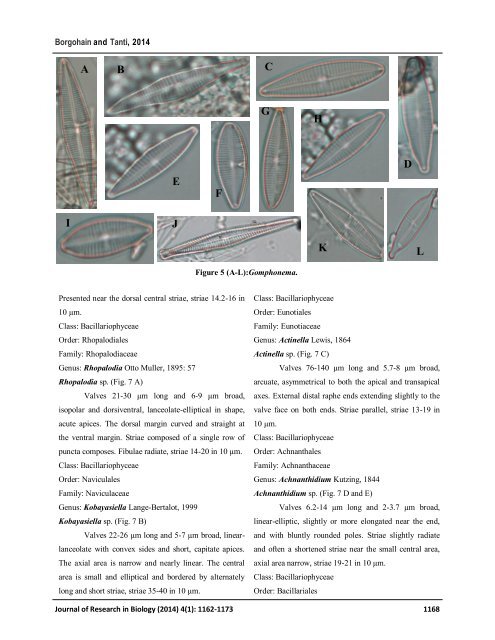Diversity of freshwater diatoms from few silica rich habitats of Assam, India
Diatoms are a ubiquitous class of phytoplankton of extreme importance for the biogeochemical cycling of minerals such as silica. Few places of Nagaon district of Assam, India viz., Jiajuri, Borhola, Thanajuri and Chapanala have been recognized as the highest silica zones by Geological Survey of India. No any research has been conducted to explore the diatom diversity at this important silica rich habitat. In the present investigation, the morphology and diversity of freshwater diatom species were investigated during May 2012 to April 2013. The samples were subjected to acid wash treatment followed by microscopic observations. Altogether 103 species of diatoms belonging to 20 genera were recorded. Occurrence of diatom varied in all the four different study sites. The dominant genera includes: Stauroneis, Kobayasiella, Eunotia, Pinnularia, Nitzschia, Gomphonema, Frustulia, Surirella, Achnanthes, Rhopalodia, Navicula, Synendra, Encyonema, Achnanthidium, Cymbella, Hippodonta, Tabularia, Actinella, Encyonopsis and Luticola. Notably, all the diatom species belonged to pennate type.
Diatoms are a ubiquitous class of phytoplankton of extreme importance for the biogeochemical cycling of minerals such as silica. Few places of Nagaon district of Assam, India viz., Jiajuri, Borhola, Thanajuri and Chapanala have been recognized as the highest silica zones by Geological Survey of India. No any research has been conducted to explore the diatom diversity at this important silica rich habitat. In the present investigation, the morphology and diversity of freshwater diatom species were investigated during May 2012 to April 2013. The samples were subjected to acid wash treatment followed by microscopic observations. Altogether 103 species of diatoms belonging to 20 genera were recorded. Occurrence of diatom varied in all the four different study sites. The dominant genera includes: Stauroneis, Kobayasiella, Eunotia, Pinnularia, Nitzschia, Gomphonema, Frustulia, Surirella, Achnanthes, Rhopalodia, Navicula, Synendra, Encyonema, Achnanthidium, Cymbella, Hippodonta, Tabularia, Actinella, Encyonopsis and Luticola. Notably, all the diatom species belonged to pennate type.
Create successful ePaper yourself
Turn your PDF publications into a flip-book with our unique Google optimized e-Paper software.
Borgohain and Tanti, 2014<br />
A B C<br />
G<br />
H<br />
E<br />
F<br />
D<br />
I<br />
J<br />
K<br />
L<br />
Figure 5 (A-L):Gomphonema.<br />
Presented near the dorsal central striae, striae 14.2-16 in<br />
10 µm.<br />
Class: Bacillariophyceae<br />
Order: Rhopalodiales<br />
Family: Rhopalodiaceae<br />
Genus: Rhopalodia Otto Muller, 1895: 57<br />
Rhopalodia sp. (Fig. 7 A)<br />
Valves 21-30 µm long and 6-9 µm broad,<br />
isopolar and dorsiventral, lanceolate-elliptical in shape,<br />
acute apices. The dorsal margin curved and straight at<br />
the ventral margin. Striae composed <strong>of</strong> a single row <strong>of</strong><br />
puncta composes. Fibulae radiate, striae 14-20 in 10 µm.<br />
Class: Bacillariophyceae<br />
Order: Naviculales<br />
Family: Naviculaceae<br />
Genus: Kobayasiella Lange-Bertalot, 1999<br />
Kobayasiella sp. (Fig. 7 B)<br />
Valves 22-26 µm long and 5-7 µm broad, linearlanceolate<br />
with convex sides and short, capitate apices.<br />
The axial area is narrow and nearly linear. The central<br />
area is small and elliptical and bordered by alternately<br />
long and short striae, striae 35-40 in 10 µm.<br />
Class: Bacillariophyceae<br />
Order: Eunotiales<br />
Family: Eunotiaceae<br />
Genus: Actinella Lewis, 1864<br />
Actinella sp. (Fig. 7 C)<br />
Valves 76-140 µm long and 5.7-8 µm broad,<br />
arcuate, asymmetrical to both the apical and transapical<br />
axes. External distal raphe ends extending slightly to the<br />
valve face on both ends. Striae parallel, striae 13-19 in<br />
10 µm.<br />
Class: Bacillariophyceae<br />
Order: Achnanthales<br />
Family: Achnanthaceae<br />
Genus: Achnanthidium Kutzing, 1844<br />
Achnanthidium sp. (Fig. 7 D and E)<br />
Valves 6.2-14 µm long and 2-3.7 µm broad,<br />
linear-elliptic, slightly or more elongated near the end,<br />
and with bluntly rounded poles. Striae slightly radiate<br />
and <strong>of</strong>ten a shortened striae near the small central area,<br />
axial area narrow, striae 19-21 in 10 µm.<br />
Class: Bacillariophyceae<br />
Order: Bacillariales<br />
Journal <strong>of</strong> Research in Biology (2014) 4(1): 1162-1173 1168

















